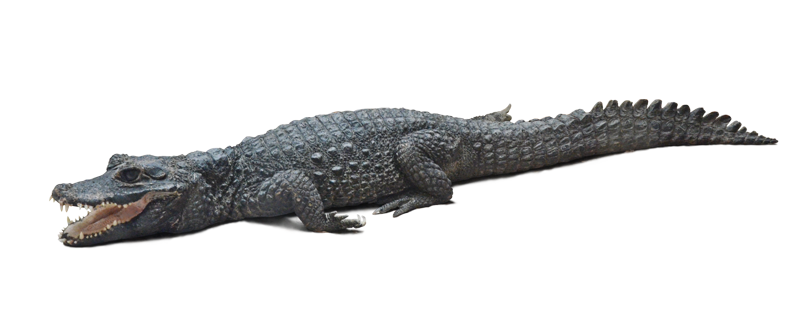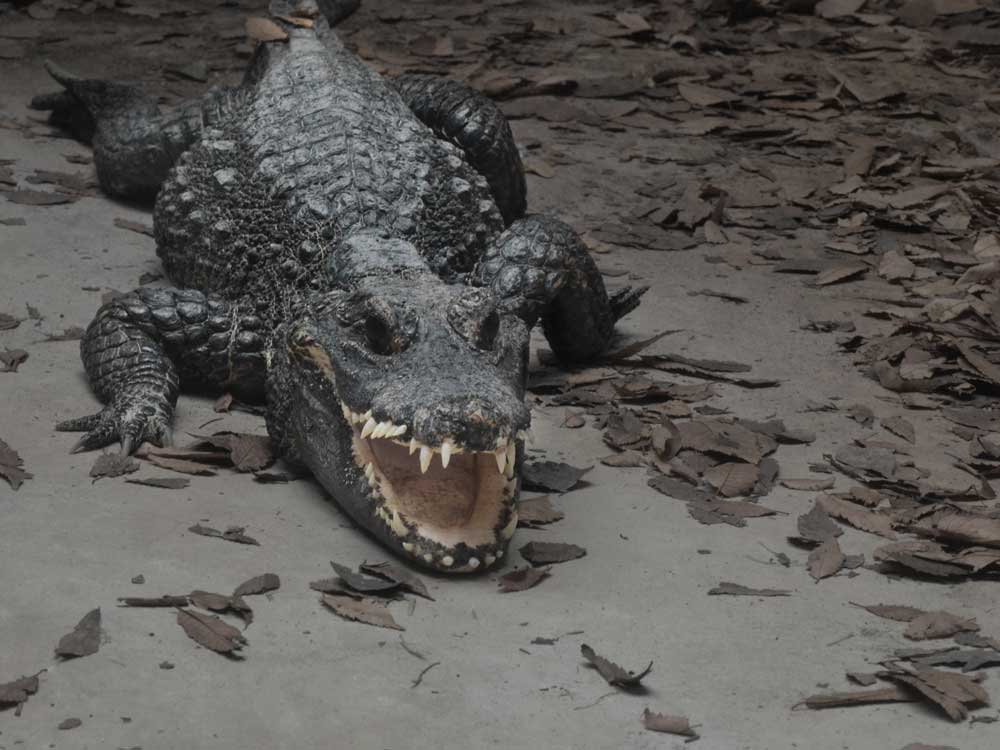
Osteolaemus tetraspis (Cope, 1861)
西アフリカの臆病なワニ
The Timid Crocodile of West Africa
サハラ砂漠以南の西アフリカ、ギニア湾岸諸国の淡水域から、ザイール(現・コンゴ民主共和国)のコンゴ川流域など、熱帯雨林地帯にかけて分布しています。全長は約200cmで、口先が短く、原始的な特徴をもつクロコダイルです。夜行性で、日中は巣穴や木の根の間などの隙間にひっそりと身を潜め、夜になると獲物を求めて水中に入り活動を始めます。
魚、貝、カニ、カエル、イモリなどの小型動物を主な餌とし、よく発達した球状の奥歯を使って、貝やカニの殻を噛み砕きます。見た目は強そうですが実際は臆病で、危険を察知するとすぐに水中や狭い場所へ逃げ込みます。これは、ワニの中でも比較的小型であり、外敵から身を守る必要があるためです。
西アフリカには、ナイルワニ(Crocodylus niloticus)、アフリカクチナガワニ(Mecistops cataphractus)、そして本種のニシアフリカコガタワニ(Osteolaemus tetraspis)の3種が生息しています。多くの民族は、宗教的または歴史的な理由からワニに特別な敬意を抱いており、「ワニがいなくなれば川は干上がる」と信じ、水の持続性と結びつけています。また、ワニはトーテムとして崇拝され、地域の穀物倉庫の守護神としても用いられてきました。
さらに、ワニの胆汁は強力な毒であると信じられており、そのため現地ではワニ肉を食べることはほとんどありません。本種やアフリカクチナガワニは野生での遭遇例が少なく、その生態については今も研究の余地が残されています。

The West African dwarf crocodile inhabits the freshwater regions of the Gulf of Guinea countries in West Africa, south of the Sahara Desert, and extends through the tropical rainforest zones of the Congo River basin in the Democratic Republic of the Congo (formerly Zaire). It reaches about 200 cm in length and has a short snout, showing primitive features among crocodiles. Primarily nocturnal, it hides quietly in burrows or crevices among tree roots during the day, emerging at night to hunt in the water.
Its diet consists mainly of small animals such as fish, mollusks, crabs, frogs, and newts. It has well-developed, rounded back teeth that allow it to crush the shells of crabs and mollusks. Despite its fierce appearance, it is timid by nature, and when sensing danger, it quickly hides underwater or in narrow spaces. This behavior reflects its relatively small size compared to other crocodiles and its need to protect itself from predators.
In West Africa, three crocodile species are found: the Nile crocodile (Crocodylus niloticus), the African slender-snouted crocodile (Mecistops cataphractus), and the West African dwarf crocodile (Osteolaemus tetraspis). Many local ethnic groups hold deep religious or historical reverence for crocodiles, believing that “if crocodiles disappear, the rivers will dry up,” symbolizing the animals’ connection to the sustainability of water. Crocodiles are also worshiped as totems and have served as guardians of village granaries.
Furthermore, crocodile bile is widely believed to be a powerful poison, and as a result, crocodile meat is rarely consumed. Both the West African dwarf crocodile and the African slender-snouted crocodile are rarely encountered in the wild, and much about their ecology remains to be studied.
参考文献
京都市動物園 | どうぶつ図鑑 | ニシアフリカコガタワニ 2024年7月13日閲覧
タノシモ | いきもの図鑑 | アクア・トト ぎふ ニシアフリカコガタワニ 2024年7月13日閲覧